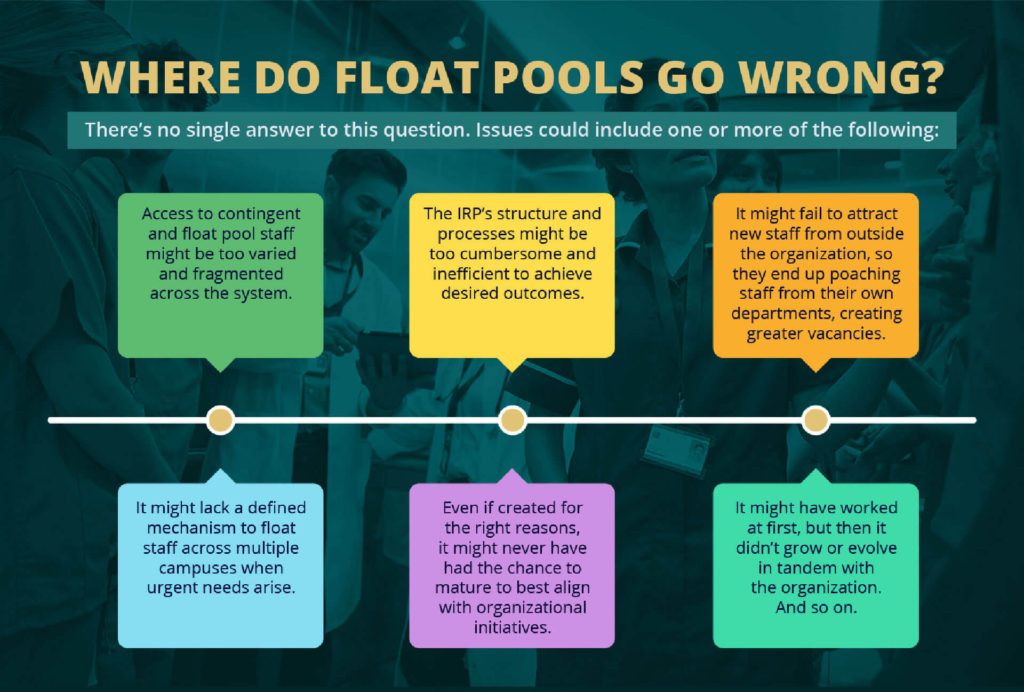Controlling labor spend
Hospital labor costs can be staggering. They typically represent 50% or more of annual operating revenue; and at a large health system, that can add up to hundreds of millions of dollars (or more) every year.
One powerful tool that many healthcare organizations use to control labor is a nursing float pool, also known as an internal resource pool (IRP). This IRP is a secondary ‘layer’ of labor support that fits between core staff and contract labor. This pool creates a lower-cost resource for contingent labor that health systems can use before turning to much higher-cost agency labor or paying a premium for overtime or incentive pay. In some cases, these pools can be designed to support multiple facilities and/or an entire health system by identifying specific business units with the highest need for labor support and deploying available staff to them. Either way, nursing float pools are typically managed through a centralized staffing team.
IRPs are so effective in delivering staff because they are fully compliant, credentialed, and oriented employees of the organization. This means that anyone scheduled through a resource pool is already active and understands the responsibilities of floating to a unit or facility to meet the demands of patient care. And they work. According to research published in Healthcare Financial Management, hospitals that use float pools can have at least 2-5% of their total nursing labor costs.

How to build a float pool
Aside from cost savings, nursing float pools can also be a great way to ease the pain of the nursing shortage, ensuring that hospitals can continuously and reliably access nursing staff to meet patient needs. This issue has become particularly acute throughout the pandemic, which has put a spotlight on all staffing inefficiencies and made clear why it’s so important to be able to deploy readily available staff across multiple locations at need.
Otherwise, hospitals are looking at skyrocketing use of overtime, critical staffing and other premium pay incentives, and traveler/agency utilization. And these avenues create a real (and negative) financial impact, as well as potentially eroding patient satisfaction, staff satisfaction, quality, safety, and patient capacity.
All of that is why one of our clients – a major health system with upwards of 10 hospitals, over a hundred ambulatory sites, and thousands of providers – wanted to build their own IRP. The problem? They had tried an IRP a few years back, only to end up disbanding it. They’re not alone; many health systems dip their toes into nursing float pools only to pull back. Indeed, even when IRPs do appear to work, they often achieve below-potential results. We’d argue that 2% to 5% savings are on the low side of potential savings when compared to a properly implemented nursing float pool program.

If nothing else, organizations who think their current nursing float pool is adequate need to ask themselves why they continue to spend millions of dollars in the agency if their existing IRP is performing optimally because in that situation there’s still ample room for improvement. If nothing else, it’s appropriate to look at how productive the IRP is (or isn’t).
The reality is that most resource pools are not fulfilling the labor goals of the organizations they were created to support. This is not necessarily the fault of any individual. It is not possible to obtain the ideal outcome without the correct strategy and tools.

Each piece is critical, and the absence of any part – or problems with any single part – will undermine the IRP and reduce how successful it can be. Let’s look at each one in turn.
Respect (and define) the Process
To start, the key is to make sure the program is a perfect fit for your organization’s processes, workflows, and strategies. If you have seen one hospital, you have seen one hospital; there is not a one-size-fits-all solution, so customization is key (as is supporting the developed strategy with the right technology platform and leading/populating it with the right people).
Also, it’s not necessary to start from zero. If you already have a nursing float pool, you’re ahead of the game. The best approach is to maximize the active staff and build upon what works. When we go into an organization, we start by looking at utilization and setting targets for productivity levels. We engage our partners on best practices and process flow.

Empower your People
Process is intimately linked to the people aspect of float pools, because the strategy behind, and the design of, the program must successfully attract the nurses you want. To do that, you need to build a program that gives the nurses the freedom and the flexibility that they want.
Instead, most hospitals build an IRP program that appeals to the administrators. The program is built to sound great to in-house decision-makers, but then no nurses are attracted to it, so the health system can’t staff it appropriately. That will undermine the productivity and performance of the IRP right away. It’s critical to build a program that is attractive to the desired workforce if you want to be able to hire them.
But how do you then deploy and manage that workforce? That’s the technology piece.

Leverage the Right Technology
One of the biggest hurdles for hospitals to optimize their IRP program is to realize that it takes more than just building the program. What they don’t have – because hospitals aren’t technology companies – is the software.
Many times, hospitals will have scheduling software to manage their core staff, their full‑time and part‑time nurses. That’s great, but that software isn’t very good at managing these contingent resources that are also going to float across lots of hospital locations.
The truth is, it’s the technology that largely enables the hospital to turn to its IRP before going into costlier overtime, incentive pay, or contract labor. That’s because managing a float pool or IRP without the technology piece is just a whole lot of work.
With the right technology in place, the workflow is automated. Admins can immediately move on to staffing the next position, putting out the next fire, or focusing on higher-priority objectives.

Where to begin your float pool process
An internal resource pool, or a float pool, can be an amazing tool for reducing labor costs (often significantly) and ensuring a steady supply of nursing resources. But to get the maximum amount of productivity out of that staff, hospitals must have three pieces all in place and all working seamlessly together: people, process, and technology.
With that, IRPs become engines of efficiency, generating better labor productivity, filling shifts faster, and – in the end – generating better patient outcomes. If you’re looking for a place to start, or strategies to optimize your float pool, contact Hallmark today.
